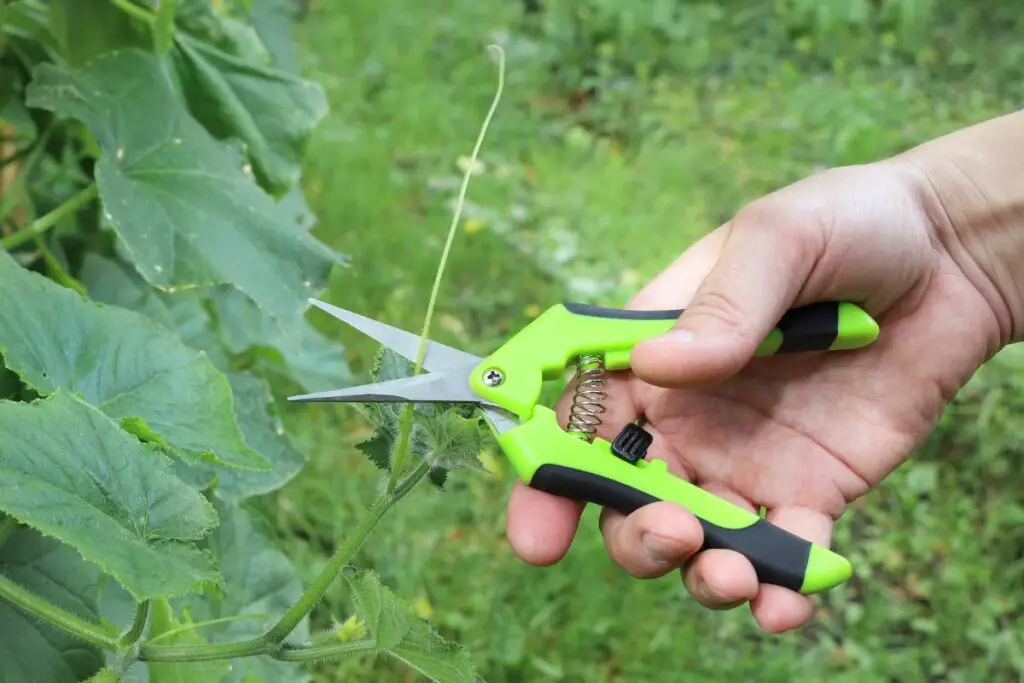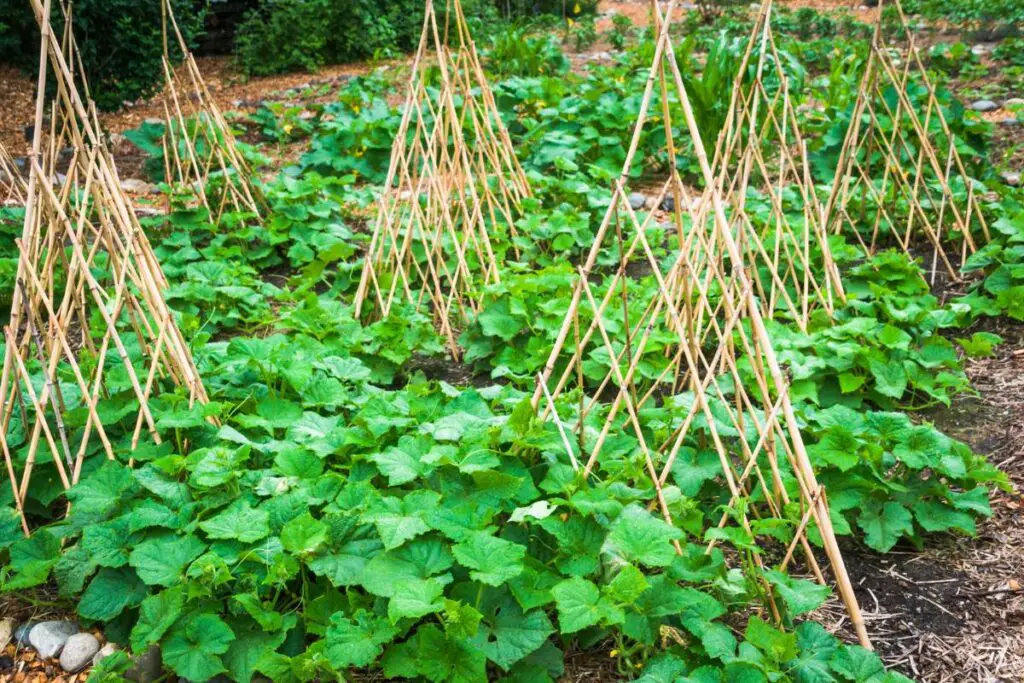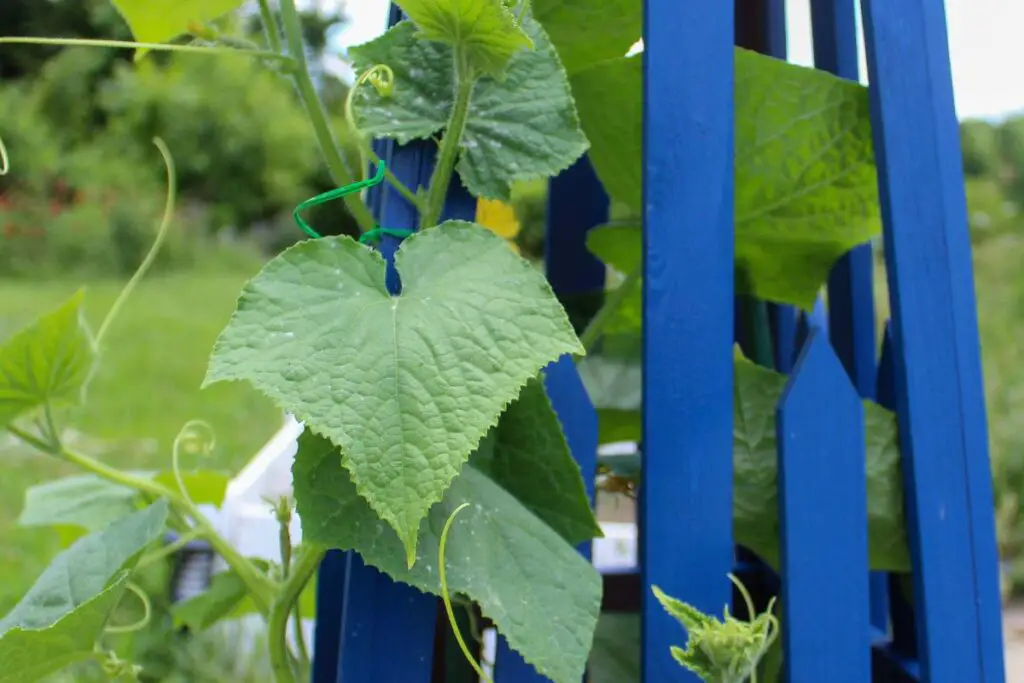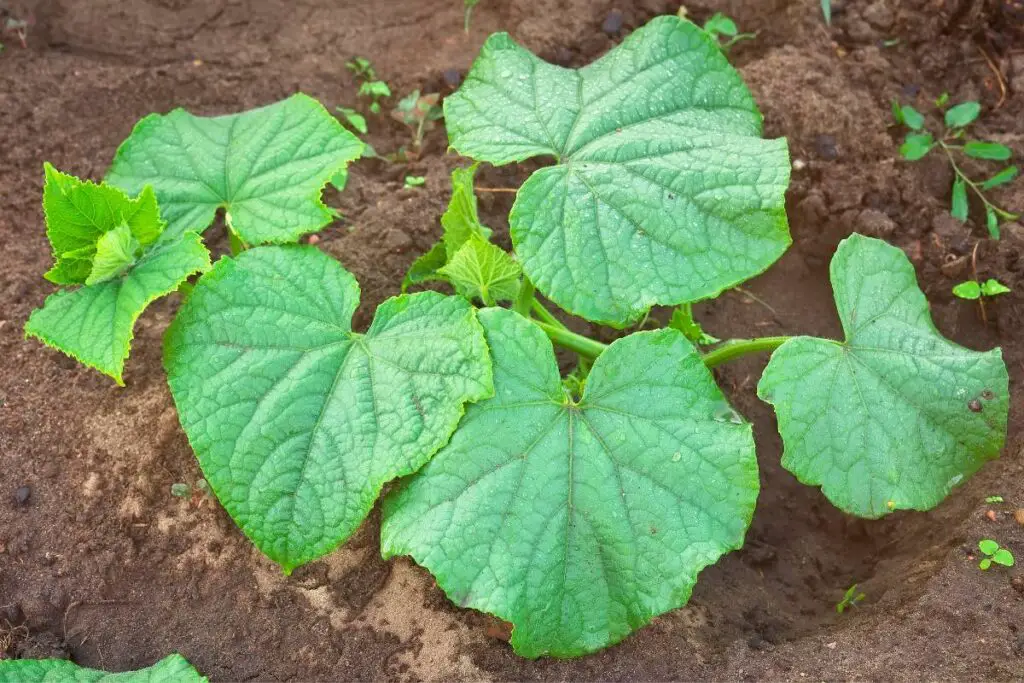Most gardeners love cucumbers. But behind those juicy and healthy fruits are months of nurture, protection, care, and maintenance. Pruning the cucumbers from time to time is one such care. But how do you do it?
Cucumbers are pruned for higher yields, adequate sunlight penetration, and enough air circulation. Clean the garden tools. Remove some lower leaves, lateral runners, suckers, outer leaves, flowers, and dead and diseased leaves. Do not prune too much, as that will stress the plant.
Pruning is easy but time-consuming. Read this article till the end to learn everything about pruning the cucumbers – the right time to prune, how to do it the right way, tools needed, and much more.

Why prune the cucumber plants?: Advantages and disadvantages
Cucumbers are famous vegetable plants.
They can be a great asset in your garden, provided you care for them.
Pruning leads to a healthy and beautiful plant.
Without pruning, the plant will cover up most spaces of your garden.
Once that happens, you cannot control their growth.
You won’t receive any fruits because the plant will keep focusing on growing new vines and leaves.
There are several merits and demerits of pruning. But the advantages outweigh the demerits.
So, let’s first see how pruning is advantageous for the cucumbers.
Advantages
- The cucumbers not only have a crawling growth habit, but they are also bushy and wild. Pruning the cucumbers a bit from time to time will help to control their bushy growth and make it easier to manage.
- Air circulation reduces when the cucumbers have too much vine and leaf growth. Pruning can improve air circulation and control diseases like powdery mildew.
- Too many leaves do not allow sunlight to penetrate the other leaves at the bottom. Pruning will create some space through which the sunlight will enter and increase the plant’s growth and fruit production.
- You cannot easily spot the cucumbers when your plant has too many leaves and vines. And harvesting them every other day is essential as over-mature fruits become bitter. Pruning will allow you to spot the fruits easily.
- Overcrowding can give rise to several diseases and pests. But pruning will reduce the chances of infestation and keep your plant healthy.
- Some gardeners have witnessed that proper pruning leads to faster ripening of the fruits and early harvest. It is beneficial for market gardens or commercial places.
- When you remove the unwanted shoots, the plant starts focusing on making new fruits and flowers, which further increases the cucumber yields.
Disadvantages
Everything will have a positive side and a negative side.
Though pruning will have some demerits, its benefits will surpass the demerits.
In addition, proper pruning techniques can address the potential downsides.
Let’s have a look at the disadvantages of pruning:
- Too much pruning will stress the plant and reduce the yields. So, the purpose of your pruning will fail.
- Pruning makes an open wound in the stems and vines. Though pruning reduces disease by increasing airflow, open wounds open the path for pathogens.
You can overcome the problem by carefully knowing the proper method of pruning.
As for the open wound, prevent it by pruning in the early morning during the dry weather so that the wounds can dry out quickly throughout the day.
Without water, most pathogens won’t survive.
Choosing the right time to prune the cucumber plants

Everything has a suitable time, and so does the cucumber pruning.
The proper season to prune the cucumbers is when they grow actively during their growing season.
If you prune the cucumbers too early when they are not established, you might damage the vines and stop their growth and fruit production.
Pruning ensures that the cucumber plants can grow and support fruits in the later growing season.
The cucumber plants are fast growers and can reach around 1 to 2 feet tall within 3 to 5 weeks.
Allow the vines to have at least seven leaves to start fruit production.
Prune the fuzzy growth tips early to allow the plant to spread laterally.
Tools and equipment
You will need the right tools and equipment to prune the plants correctly for pruning.
Some pruning can be done through pinching, but I prefer pruners because it perfectly cuts and prevents damage.
With the right pruning tools, you can do it correctly and even save the plants from getting wounded or damaged.
Here are the tools you will need for pruning the cucumbers:
- Pruning shears helps to cut the shoots at the main vines and the sub-vines from the main vines.
- Secateurs are used to prune the damaged vines. You will have various options to choose the right type of secateurs. They have different blades, sizes, and orientations for left and right-handed people.
- Loppers are used where you cannot use the secateurs, like the thick stems. The mini and lightweight models would be ideal for the cucumbers.
- Garden scissors are for pruning the flowers from the early stage and thin vines and shoots.
- The long-reach pruners help in cutting off the shoots or vines that are difficult to reach, especially those growing in caged-like trellises. The pruner’s long arms make it suitable to reach these vines.
Basic principles of pruning the cucumber plants
When you prune the cucumber plants, you need to follow a few principles for successful pruning:
- You should know the right time for pruning. Pruning stresses the plant, and the actively growing season helps it recover better.
- Let your plant establish well to handle the pruning. Always prune after the plant has reached 1 to 2 feet tall. Before that, the plant gets stressed.
- The right place to cut is also essential. The main stem will have nodes with one leaf, fruit, tendril, and a new stem. Leave around ½ to 1 inch of the stem, and then cut. For example, if you start from the bottom, find the lowest 5 to 7 nodes and remove the shoots.
- Begin with the dead, diseased, or bottom leaves, and then the other parts.
- Try thinning out the dense growth so the plant receives adequate sunlight, airflow, and oxygen.
- Prune regularly to keep your plant healthy and in shape.
Identifying the pruning targets: Understanding the cucumber plant anatomy
Understanding the anatomy of the cucumber plants makes it easier to find the pruning targets.
Here is a short brief about the plant’s anatomy:
- The main stems support the plant by growing vertically from the base.
- The lateral branches are the side shoots that develop from the main stem at the leaf nodes. The suckers are types of lateral shoots that grow between the leaf nodes.
- We already know about leaves. The large green leaves are attached to the stem.
- The leaf nodes are the areas from where the leaves develop. Even the lateral branches and flowers emerge from the nodes.
- The tendrils are the thin, spiraling structures that develop from the leaf nodes. These are not to be pruned.
- The flowers are yellow. The male flowers grow in clusters, whereas the female flowers grow individually on a stem. After pollination, the male flowers dry out and sometimes fall off. The female flowers produce the fruits.
You have to prune the lateral branches and suckers, the extra leaf growth, and some flowers out of these.
The main vine will only require pruning when it exceeds the desired growth.
Looking for gardening supplies? We have tested 100's of products before recommending them to you guys. Check out our best pick below:
| Image | Gardening Supplies | Best Price? |
|---|---|---|
 Top
Top Top
Top | Raised Garden Bed Kit | Check On Amazon |
 | XLUX Soil Moisture Meter, Plant Water Monitor, Soil Hygrometer Sensor for Gardening, Farming, Indoor and Outdoor Plants, No Batteries Required | No Results |
 Top
Top Top
Top | 82 Pcs Garden Tools Set and Extra Succulent Tools Set | Check On Amazon |
 | Joeys Garden Expandable Garden Hose with 8 Function Hose Nozzle, Lightweight Anti-Kink Flexible Garden Hoses, Extra Strength Fabric with Double Latex Core, (50 FT, Black) | No Results |
 Top
Top Top
Top | Dual Chamber Compost Tumbler | Check On Amazon |
 Top
Top Top
Top | Sunnyglade Plant Stakes | Check On Amazon |
 Top
Top Top
Top | Organic Cold Pressed Neem Seed Oil | Check On Amazon |
 Top
Top Top
Top | Mighty Mint Gallon :-Insect and Pest Control Peppermint Oil | Check On Amazon |
 Top
Top Top
Top | Scotts DiseaseEx Lawn Fungicide | Check On Amazon |
 Top
Top Top
Top | Jacks Classic 20-20-20 All Purpose Fertilizer | Check On Amazon |
 Top
Top Top
Top | 30,000 Seeds Pollinator Attracting Wildflower Mixture | Check On Amazon |
 Top
Top Top
Top | Survival Vegetable Seeds Garden Kit-Over 16,000 Seeds | Check On Amazon |
How to prune the cucumber plants?: Step-by-step guide
Pruning requires a bit of knowledge in the beginning.
Once you learn the correct way to prune, it becomes easy after some time.
Collect all the materials and disinfect them with sanitizers or rubbing alcohol.
Now, start pruning from the bottom of the plant.
Identify the main vines and consider topping
Before you start pruning, it is essential to identify the main vines.
During the growing season, you must prune the vines from the main vines.
Prune some main vines at the end of the growing season once it crosses their desired height and becomes overcrowded.
It is called topping.
It will encourage the plant to prevent growing upwards, produce lateral shoots to bear the flowers and fruits, and encourage fast ripening of the fruits.
Examine the plant closely and find out the main vine from it.
You can remove some adult and mature vines from the plant.
These are the vines that will get ignored most of the time.
Leave around ½ to ¼ inch of the stem and cut it at a 45-degree angle.
Maintaining this will ensure the safety of the main stem and the central vine.
Remove the damaged and diseased leaves
It is essential to remove the damaged and diseased leaves from the plant.
When these leaves stay in the plant, it keeps using the energy to revive these plants back to life.
As a result, your plant has no new growth, be it leaves or flowers.
Removing these leaves will stop the plant from using the energy behind them and start focusing on making new leaves, flowers, and fruits.
Look for dry, discolored, and spotty leaves and remove them.
If you suspect any infestation, use some insecticides or pesticides.
Also read: 17 Problems With Cucumber Plants(+Quick Fix)
Prune the lateral runners and lower leaves
When you closely inspect the plant, you will find the leaves near the ground.
Remove these leaves.
Too many bottom leaves can reduce airflow and trap moisture in the ground, leading to fungal diseases.
Removing these leaves will improve air circulation and prevent diseases like powdery mildew.
Do not touch the upper leaves unless needed.
When the sunlight is too intense, the upper leaves shade the fruits and prevent burns.
Also, remove the first lateral runners on the plant to increase fruit productivity.
After removing the first five runners, let the remaining runners grow well throughout the season.
Remove the suckers
Check for suckers at the base of the plant between the nodes.
They can grow every few weeks, and you must prune them 1-2 times monthly.
You will have an offshoot from the main vine with a large leaf.
Along with that, you will also have a small offshoot with an undeveloped leaf.
This offshoot with the incomplete leaf is the sucker.
As the name suggests, the suckers will suck all the nutrients from the plant and reduce fruit productivity.
The harvest size will be less than usual, even if there are fruits.
Pruning them will allow the plant to use the nutrients and energy to make fruits.
There will be some young suckers measuring a few inches long. Pinch them off the plant.
Leaves, fruits, and flowers
Prune some outer leaves, fruits, and flowers.
It will keep the plant in check, improve airflow and sunlight penetration, and not hinder harvest.
Prune the outer leaves that are turning unruly.
It will stop the plant from using the energy to revive those leaves and divert its attention toward making new leaves and flowers.
After the pollination, some male flowers will dry out.
Try locating and removing these flowers.
To make the plant fuller at the top, remove some flowers from the bottom of the plant.
It will allow the plant to focus on sending nutrients to the remaining flowers.
Leave the tendrils
Tendrils are another central part of the plant that needs to be left undisturbed while pruning.
The tendrils are the small curly parts in the plant that attach the plant to the trellis and climb.
If you prune the tendrils, it will negatively affect the main vines, as they depend upon these tendrils.
So, do not remove any tendrils from the plant.
Let them be and allow them to keep adding support.
Managing the cucumber plant size and shape through pruning

Cucumbers have crawling habits and can have unruly growth if not controlled.
One way to control them is by pruning them occasionally to keep them in shape.
Pruning the dead and damaged leaves maintains the physical appearance of the plant.
The lower leaves will gather a lot of dirt and make the plant look odd, clean at the top, and dirty at the bottom.
So, remove these leaves as well.
The vines that are longer than 6 feet look odd in the plant.
Pruning these vines and maintaining their length will keep the plant in proper shape and size.
Pruning the cucumber plants for air circulation and disease prevention
Air circulation and disease prevention are done when removing lateral shoots from the cucumber plants.
These shoots are the side branches that grow off the main vine or stem.
When these shoots become too overcrowded, they reduce airflow and encourage diseases.
Prune them off at the base. Let each plant have only 2-3 lateral shoots.
This many shoots will encourage the plant to have some fruit-bearing branches.
Pruning for increased sun penetration and fruit quality
For increased sun penetration and fruit quality, remove some outer leaves.
When the cucumbers grow too many leaves exteriorly, the sunlight cannot reach the interior parts of the plant.
Without the proper amount of sunlight, the plant cannot photosynthesize well.
As a result, there will be lesser yields.
Pruning some outer leaves helps the sunlight reach every part of the plant and increases the fruit quality.
Pruning the cucumber plants in different stages: From seedlings to mature plants
When you prune the cucumber, you start after the plant reaches 1-2 feet.
There is no pruning time based on the different stages.
You can only start pruning when the plant reaches 1-2 feet.
You have to prune them regularly, once a week, for the whole growing season.
The plant will become 1-2 feet tall after 3 to 5 weeks. It will be the early growth stage.
During the early growth stage, remove some suckers.
These parts suck up all the nutrients and don’t allow the plant to grow new leaves and flowers.
The flowering and fruit growth stage will arrive after a few more weeks.
At that time, remove the overcrowded lateral branches.
It will help the plant improve air circulation and sun penetration and encourage new growth.
You can also remove some early flowers if the female flowers appear late.
Pollinating with the older male flowers reduces the chances of pollination.
The chances of yields through pollination are higher when the female flowers pollinate with the newly grown male flowers.
If the plant becomes taller than the desired length, trim the main stems at the end of the growing season.
Encourage side branches, and bring them in shape.
Over time, you find diseased, dried, or dead leaves in the plant.
Remove them immediately.
Remove some outer leaves and mature vines if the plant has become too overcrowded in the mature stage.
Cucumber pruning variations
We have already learned the right way to prune, the time, and the parts to prune.
Now, we shall learn about pruning variations, i.e., based on the cucumber varieties.
You need to prune the cucumbers based on the variety to maintain their plant size and fruit yields.
The varieties that grow small cucumbers will not require heavy pruning.
The small fruits put less stress on the plant and do not utilize all the nutrients.
So, the plant can still support full-grown fruits even if there are too many leaves and shoots.
But if you are growing the varieties that produce larger fruits, you have to prune these plants heavily.
Maximum nutrients get used up by vegetation, and less amount is left for the fruits.
As a result, either the yield is low, or the fruit size gets compromised.
So, pruning these varieties allows the fruits to receive some nutrients to grow at their full potential.
The varieties with smaller fruits grow more than one fruit per leaf node, but the large fruit varieties produce only one fruit per node.
Keep these things in mind before you prune the plants.
Another variation is the determinate vs. the indeterminate.
The determinate varieties are the bushy compact varieties.
These grow at a certain height and then stop growing.
So, these will not need any heavy pruning.
In contrast, the indeterminate varieties are the vining varieties that require heavy pruning because they are uncontrollable.
The plant can get very tall and extensive if not pruned well.
You must prune these varieties regularly to keep them in shape, improve air circulation, help in sun penetration, and encourage fruit production.
Common mistakes made in the cucumber pruning and troubleshooting the issues

If you don’t prune the cucumbers correctly, you may encounter problems afterward.
The problems are the results of the mistakes you make while pruning.
Below are a few mistakes a beginner can make and the ways to troubleshoot and prevent them:
Removing too many leaves
When the plant grows too many leaves, it uses energy to grow more.
As a result, there is a lack of fruits and flowers, air circulation, and sunlight.
That is why some leaves are pruned.
But, the plant will need an adequate amount of leaves for photosynthesis.
If you keep pruning too many leaves, this will reduce the plant’s ability to produce flowers and fruits.
So, you will have a lower yield and a weak plant.
Do not prune more than 20% a day.
Inspect the plant closely every week, understand whether it needs pruning, and then attempt it.
Cutting the main stems too early
Prune the main stem only when the plant is well-established and has reached the desired height.
Generally, pruning should begin after the plant has reached 1-2 feet tall. Pruning before that will stress the plant and weaken it over time.
Overcrowding
Make sure you are pruning the right amount of lateral shoots.
Leaving too many shoots will overcrowd the plant again in no time.
You will again have to prune them.
If you ignore them because you have recently pruned them, the shoots will overgrow and take up the nutrients.
Over time, they will overcrowd the plant, grow more lateral shoots, block the sunlight and airflow, and encourage diseases.
Each plant should have around 2 to 4 lateral shoots, and remove the rest.
Precautions to take while pruning
Follow these precautions while pruning the cucumber plants:
- Always clean and sanitize your gardening tools before and after pruning. Otherwise, the disease will spread to the plants.
- Wear gardening gloves while working to keep your hands safe from thorns, rough stems, and dirt.
- Avoid pruning the plants during stress periods, for example, extreme weather conditions, infected plants, or a suffering plant.
- Only prune up to 20% of the plant at a time. More than this on a single day at once will stress and wilt the plant.
Pruning aftercare
After pruning, the plant stays a bit stressed. But your plant will return to normal with the proper care and maintenance after trimming.
Here are some post-pruning tips for the cucumber plants:
- Provide your plants with adequate moisture. Please wait a bit for the wound to heal because it heals better when the surrounding is dry.
- Fertilize them regularly. It will encourage new growth faster.
- Instead of growing the cucumbers over the ground, provide some support with trellises.
- Make sure it is receiving 6 to 8 hours of sunlight. But it should not be too intense.
- Since you have pruned, an open wound that can encourage infestations will remain. So, regularly check for pests and diseases and keep the surroundings ideal until the wounds heal. Most importantly, avoid overwatering.
- Avoid stressing the plant further.
- Check the plant daily until the wounds are dry and the plant shows positive growth signs.
- Pruning the cucumbers regularly once a week.
Final thoughts
Always prune during the growing season. Choose a dry day so that the wound caused by pruning dries away. Pruning encourages new growth, be it fruits or leaves, improves air circulation, allows sunlight penetrations, and increases yields. Beginners start pruning the cucumbers when they notice dead and damaged leaves.
But the right time to start pruning is when the plant reaches 1-2 feet tall and has grown too many leaves and shoots. Identify the main vines to understand the growth of the other parts. Prune the lower leaves, the lateral runners, the suckers, and the damaged leaves.
You may also have to prune some main vines if it exceeds the desired length. After that, check the condition of the flowers and remove the dried ones. Once acquainted with the cucumber plant’s anatomy, finding the right parts and spot becomes easy.
How frequently should I prune the cucumber plants?
Generally, it is recommended to prune once a week, but there is no fixed frequency. If you do not find so much growth, there is no need to prune weekly.
Can I pinch off the flowers or shoots?
Though it is always better to use pruning shears, you can use your hands to prune the flowers and some small shoots or young suckers.
Reference: Pruning Wikipedia
